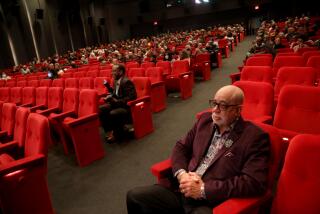Old-fashioned wet shaving is back in style
Reporting from Chicago — Austin Winston is discovering the art of the old-fashioned shave.
Each day, the 21-year-old engineering student walks into his dormitory bathroom at the Illinois Institute of Technology toting a basket of shaving supplies reminiscent of his grandfather’s generation: hand-held bowl, cotton washcloth, round bar of shaving soap, double-edged safety razor, stainless-steel straightedge razor, badger-hair shaving brush and a good dose of patience.
“You have to be really careful, because you pay for your mistakes,” said Winston, stretching the skin on his neck with his fingers and running a straightedge razor across his throat. “You know you’re doing it right when you know the blade is on your skin but you don’t feel it. It’s cool.”
Winston is part of a growing cadre of shaving aficionados turning to the Internet to learn what the convenience-driven era of their fathers never taught them. Rather than standing at bathroom sinks next to their dads, the men are sitting in front of computers watching YouTube videos and reading blogs that demonstrate the intricacies of traditional shaves: how to properly hold a safety razor, techniques for building a good lather and even a 22-step breakdown of the anatomy of a straight razor.
Although traditional wet shaving is a niche market, it is gaining so much momentum that Procter & Gamble Co.’s Gillette — with 70% of the market, it’s the king of disposable razors — has jumped into the game. Since P&G acquired the Art of Shaving in 2009, the New York-based shaving boutique and product line has become the fastest-growing brand in P&G’s beauty and grooming division, company spokesman Damon Jones said.
P&G has been pouring money into expanding the Art of Shaving’s retail presence, once primarily confined to high-end department stores.
In the last two years, the number of Art of Shaving stores has doubled, to 63, and more than half have a barbershop inside where men can get an old-fashioned, hot shave. The wood-paneled stores sell $45 shaving soaps in teak bowls and $150 badger brushes in an atmosphere reminiscent of a 19th century English barbershop.
Traditional wet shaving got a big boost last year when Cincinnati-based P&G launched a national advertising campaign, Art of Shaving’s first since it was founded in 1996, touting the “brotherhood of shaving.”
Mark Herro, the most-watched shave expert on YouTube, with more than 4.6 million views, launched his shaving career in 2004 after his wife, weary of his 5 o’clock shadow, gave him an anniversary gift of a barber shave. Herro liked the smooth feel of his skin so much that he bought the tools to give himself a barber-style shave at home.
Noticing a dearth of information online about how to shave, the Texas A&M University telecommunications manager began posting how-to videos on YouTube under the handle mantic59 and created a shaving blog called Sharpologist.
His following soared as men, already schooled in the grooming practices of the metrosexual movement, connected with the machismo of facing a straightedge blade.
“For a lot of college-age men, there is an element of being a badass for shaving with a straight razor,” Herro said. “The metrosexual thing has run its course.”
The shaving revival goes hand in hand with the millennial man’s desire to express his individuality, said Stephen Hahn-Griffiths, chief strategy officer at Leo Burnett in Chicago. The advertising agency released a study that asserts a new definition of masculinity is taking shape, saying, “the universal archetype of masculinity is over.”
Whereas it was recently in vogue to be metrosexual — a term popularized a decade ago to describe straight, urban men willing to embrace their feminine sides — the current man is about self-expression, the study said. Men ages 18 to 40 are spending more time on their appearances, curating their individual styles.
“It’s less about being Neanderthal or clean cut, but about variations of those two extremes,” Hahn-Griffiths said. “It’s about finding your own personal look. It’s not manicured, but it’s still cool.”
Another reason traditional shaving is on the rise is that it saves money and is eco-friendly, experts said. Although a safety razor can cost $25 to $200, the replacement blades cost as little as 20 cents each. Even the premium stainless-steel blades, at more than $1 each, are less expensive and last longer than disposable razor cartridges.
The wet-shave revival is also boosting the barber profession. Retro-style barbershops, such as State Street Barbers in Chicago and F.S.C. Barber in New York and San Francisco, are popping up in big cities as men bypass the hair salon for a more masculine experience.
The number of U.S. barber schools rose 8% last year, to 454, from 420 in 2010, according to the National Assn. of Barber Boards of America. And the number of barbers has climbed to about 250,000 from 225,000 two years ago.
Charles Kirkpatrick, executive director of the Arkadelphia, Ark., trade group, said he has been getting inquiries lately from business owners from Miami to Brooklyn, N.Y., asking him if he knows barbers who can shave. And former barbers are calling in to renew their licenses after losing other types of jobs.
“A barber manufactures what he sells, and we don’t have to worry about [our customers] flying to China to get a haircut,” Kirkpatrick said.
More to Read
Inside the business of entertainment
The Wide Shot brings you news, analysis and insights on everything from streaming wars to production — and what it all means for the future.
You may occasionally receive promotional content from the Los Angeles Times.










